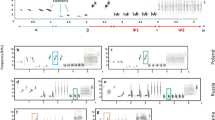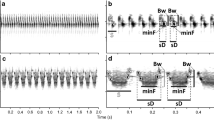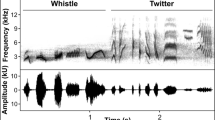Summary
We report an experiment designed to test the ideas that: 1. male songbirds can use cues from the distortion of song by environmental factors (degradation) to estimate the distance of another singing male; 2. song degradation is assessed by reference to an internal standard. Great tits respond more strongly to undegraded than to degraded songs when both are played at the same amplitude and from the same position in the territory. This difference in response is shown only if the playback song is “familiar” to the test bird; familiar songs being those sung either by the test bird or neighbours of the test bird. We interpret these results as evidence that cues from song degradation can be used to estimate the distance of a singing conspecific and that degradation assessment is only possible if the bird has an internal representation of the song (because either it and/or a neighbour sings the song). We discuss the implications of these results for Morton's (1982) ranging hypothesis, and for the distinction between learning and performance in bird song. Our results partially support the ranging hypothesis, but question the nature of “unrangeable” songs sensu Morton. The finding that birds can assess the degree of degradation of songs that they do not sing, supports the idea that birds learn more songs than they sing.
Similar content being viewed by others

References
Bekesy G von (1960) In: Weaver EG (ed) Experiments in hearing. McGraw-Hill, New York
Coleman PD (1962) Failure to localize the source distance of an unfamiliar sound. J Acoust Soc Am 34:345–346
Coleman PD (1968) Dual role of frequency spectrum in determination of auditory distance. J Acoust Soc Am 44:631–632
Dickinson A (1980) Comtemporary animal learning theory. Cambridge University Press, Cambridge, UK
Falls JB (1982) Individual recognition by sound in birds. In: Kroodsma DE, Miller EH (eds) Evolution and ecology of acoustic communication in birds, vol II. Academic, New York, pp 237–278
Falls JB, D'Agincourt LG (1982) A comparison of neighbour — stranger discrimination in eastern and western Meadowlarks. Can J Zool 59:2380–2385
Falls JB, Krebs JR, McGregor PK (1982) Song matching in the Great tit (Parus major): the effect of similarity and familiarity. Anim Behav 30:997–1009
Gish SL, Morton ES (1981) Structural adaptations to local habitat acoustics in Carolina Wren songs. Z Tierpsychol 56:74–84
Krebs JR (1976) Habituation and song repertoires in the Great Tit. Behav Ecol Sociobiol 1:215–227
McGregor PK, Falls JB (in press) The response of Western meadowlarks (Sturnella neglecta) to the playback of degraded and undegraded songs. Can J Zool
McGregor PK, Krebs JR (1982) Song types in a population of Great tits (Parus major): their distribution, abundance and acquisition by individuals. Behaviour 79:126–152
McGregor PK, Krebs JR, Ratcliffe LM (1983) The response of great tits (Parus major) to the playback of degraded and undegraded songs: the effect of familiarity with the stimulus song type. Auk 100:898–906
McGregor PK, Falls JB, Horn AG, Todd MA (1984) Sound degradation and distance estimation in western meadowlarks and humans. In: Barclay RMR, Sealy SG, Shay JM, Sheridan MT (eds) The University of Manitoba field station (Delta Marsh) 18th annual report. University of Manitoba, Winnipeg, pp 105–115
Mershon DH, King LE (1975) Intensity and reverberation as factors in the auditory perception of egocentric distance. Percept Psychophys 18:409–415
Morton ES (1982) Grading, discreteness, redundancy and motivational-structural rules. In: Kroodsma DE, Miller EH (es) Evolution and ecology of acoustic communication in birds, vol I. Academic, New York, pp 183–212
Richards DG (1981) Estimation of distance of singing conspecifics by the Carolina wren. Auk 98:127–133
Richards DG, Wiley RH (1980) Reverberations and amplitude fluctuations in the propagation of sound in a forest: implications for animal communication. Am Nat 115:381–399
Wiley RH, Richards DG (1978) Physical constraints on acoustic communication in the atmosphere: Implications for the evolution of animal vocalizations. Behav Ecol Sociobiol 3:69–94
Wiley RH, Richards DG (1982) Adaptations for acoustic communication in birds: sound transmission and signal detection. In: Kroodsma DE, Miller EH (eds) Evolution and ecology of acoustic communication in birds, vol I. Academic, New York, pp 131–181
Author information
Authors and Affiliations
Rights and permissions
About this article
Cite this article
McGregor, P.K., Krebs, J.R. Sound degradation as a distance cue in great tit (Parus major) song. Behav Ecol Sociobiol 16, 49–56 (1984). https://doi.org/10.1007/BF00293103
Received:
Accepted:
Issue Date:
DOI: https://doi.org/10.1007/BF00293103



